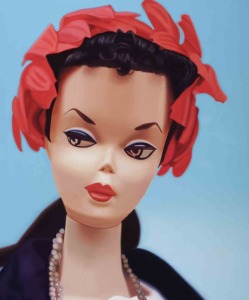 Created in 1959 by Ruth and Elliot Handler, co-founders of Mattel, described as a “new kind of doll from real life.” She debuted as an eleven and one-half inch teenage fashion model, an adult like figurine that liberated young girls from a toy market dominated by baby dolls. Barbie’s extreme success can be attributed to the world that Mattel created around her, one that was based in the lifestyle of the postwar era, its fascination with high fashion, and the popular emphasis on teen culture in America. Charlotte Johnson, the original designer of Barbie’s extensive collection of outfits and accessories, drew inspiration from the actual haute couture of Paris to cultivate the doll’s modern image.
Created in 1959 by Ruth and Elliot Handler, co-founders of Mattel, described as a “new kind of doll from real life.” She debuted as an eleven and one-half inch teenage fashion model, an adult like figurine that liberated young girls from a toy market dominated by baby dolls. Barbie’s extreme success can be attributed to the world that Mattel created around her, one that was based in the lifestyle of the postwar era, its fascination with high fashion, and the popular emphasis on teen culture in America. Charlotte Johnson, the original designer of Barbie’s extensive collection of outfits and accessories, drew inspiration from the actual haute couture of Paris to cultivate the doll’s modern image.
Through the creative efforts of Johnson and her Mattel team Barbie assumed an identity and life of her own; she became defined by the hundreds of accessories and outfits that comprised her world. Her charm and meaning in the hearts of those who played with her, loved her, and watched her grow over the years extended beyond that of a simple inanimate object of child’s play; she had a life story and a soul. Barbie’s extreme success can be attributed to the world that Mattel created around her, one that was based in the lifestyle of the postwar era, its fascination with high fashion, and the popular emphasis on teen culture in America. Charlotte Johnson, the original designer of Barbie’s extensive collection of outfits and accessories, drew inspiration from the actual haute couture of Paris to cultivate the doll’s modern image.
Barbie’s image and wardrobe provide a chronological narration of the social and cultural history of the latter half of the twentieth century. Always en vogue, Barbie acted as a barometer for the current trends of each era which were indicative of the social and political climates in America and overseas. Her wardrobe was paramount to her popularity and, in addition to being a mirror of the fashions and attitudes of society, all her clothing was impeccable designed. Meticulous attention was paid to the detail and craftsmanship of her outfits. Each piece was hand-sewn and highly detailed with real pockets, satin lining, fine fabrics, and finished off with a label and logo. Barbie’s genuine mink stole remains one of the most coveted pieces in her wardrobe and, originally available at Sears for $9.99, was also her most expensive. Barbie gave young girls access to the fantasy world created in the fashion magazines through images by photographers such as Richard Avedon and Irving Penn; she was a miniature diva that offered affordable glamour.
The ever-famous Roman Holiday Holiday Barbie attests to both the quality of the workmanship and the significance to the greater context in which each outfit was conceived. The handsome suite came with a white purse, black-rimmed glasses in matching case, a plastic comb, and hankie. This set also included the rare tiny brass compact complete with a mirror, powder puff, and engraved with a “B.” The Roman Holiday ensemble, with its inspiration in the Audrey Hepburn movie of 1954, was available only during Barbie’s debut year and highlighted the burgeoning affinity for all things Italian. When Italian movie studio, Cinecitta, opened its doors to Hollywood in the early fifties – proving American cinema with a new home in Italy- starlets began exploring the country and its unique style. The growing fascination with Italian culture helped Italian designers gain autonomy from Paris couture thus marking a new epoch in the world of fashion.
